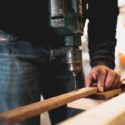How to Fix Loose Chair Legs? – A Very Useful Guide
Contents
After years of being pulled and pushed here and there, chairs often become loose, thanks to their old wood that dries as it continues to age. As their vascular tissues shrink, the legs begin to break away from the glue that had held them to the seat for decades.
It all starts with small creaks, some wobbles and before you know it, the rungs are popping out from left, right and centre. Notably, this is frequent with new furniture as compared to the solidly constructed older ones, old is gold, so they say. Needless to say, you don’t want to keep on investing in new chairs, right?
We have seen every problem that all sorts of chairs can have. As you would expect, we have fixed them. Honestly, there is nothing complex about fixing, specifically, a loose chair leg. However, valuable or antique pieces may call for professional treatment considering their value.
Sharing is caring, for that reason, here are some tried-and-tested guides on how to fix loose chair legs to stand the test of time. The guide is structured in consideration of various chair legs’ parts for your optimal help depending on where the shoe pinches most.
Selected Videos
How To Glue Loose Rungs
As the strengthening crosspieces in the structure of a chair, rungs are probably one of the most critical parts to be considered while fixing loose chair legs. How do you go about it?
- Re-glue the loose rungs. Start by removing the old glue then sand the ends of the rung clean, down the piece of wood.
- Insert wood glue into the opening of the leg by use of a syringe. This ensures the glue lands on its intended position without completely removing the rung.
- Insert the rung.
- Clamp your chair tightly until the glue dries.
There’s more than one way to skin a cat, therefore if gluing the loose rungs don’t bear fruits, you might need to add right-angle corner braces. The braces are readily available in virtually all hardware. If you wish to paint the braces to match the colour of your chair, ensure you buy a printable type.
Fix the braces where the legs meet the seat. Bend the braces, where necessary, to ensure they flush against the chair leg thus eradicating any gap between the brace and the legs. To prevent the wood from a possible split, drill pilot holes before inserting the screws into the braces.
Well, that’s all when it comes to fixing that crucial part of your chair legs. Next bit we look into how we fix the real elephant in the room-loose chair legs.
How To Fix Loose Chair Legs

Virtually all of us are guilty of dragging chairs instead of picking them up. What many don’t know is that by dragging these pieces of furniture, we put loads of pressure on their legs and can cause them to come off. The process of ‘surrender’ obviously starts with them becoming very loose.
Unfortunately, some people worsen the problem by drilling screws through the furniture to secure it, something that ends up splitting the wood. Instead, this is how you should handle a loose chair leg.
- Start by sanding the part of the chair leg that faces the furniture. This is meant to remove any old glue thus allowing the glue to form a stronger bond.
- Apply wood glue to the sanded parts and clamp the leg firmly in its right position.
- Use fasteners for extra security. Pre-drill to prevent the wood from splitting.
- Drive two screws that allow you at least two inches to bite into the chair leg.
- Fill the resultant holes with wood fillers, sand that surfaces to smoothen it, and finally apply a finish.
In some cases, you’ll find furniture starting to separate at the points where two pieces of wood meet. A simple solution to this is to add flat corner braces. These won’t drill holes into your pockets, yet they’re pretty vital.
Braces eliminate having drive screws in the hope of closing any gaps. Fix the braces in an inconspicuous position, like at the back of the chair.
Clamp the furniture for an extra contact, drill pilot holes through the bracket then drive in your screws. That’s all.
Use Of Metal L-Brackets
This method of fixing loose chair legs isn’t very different from what we’ve already alluded to on braces. However, for this fix, some experience with cordless drills may be needed. Below are some of the minor directions:
- Thoroughly assess your chair for loose parts by jiggling to examine and note the extent of legs movement.
- Position the L-bracket as if it’s to fix the chair’s leg to its frame.
- While ensuring the centre hole is in the right position where the screws will hold the brace, mark the exact outline of the bracket. It might prove beneficial to mark through the marked circles for an easy approximation of the exact centre for the screw to get drilled.
- Use the drill to secure the L-brackets to the chair legs.
- For extra grip and durability, use some wood glue at the joints of the chair legs. Remember to use a rag to wipe away any excess wood glue.
- Tighten the existing hardware attached to the legs before fixing the L-brackets to the chair.
- Finally, screw the other side of the L-bracket to the base of the chair and you’re done.
How To Reinforce A Loose Wood Chair Leg
The necessary things are:
- Sandpaper
- Measuring tape
- Marker
- Screw
- Glide
- Drill bit
- Dowel rod Glue
A loose chair is a very frightening thing. You don’t know when you can fall off from the chair.
The whole chair may collapse under pressure. Do the following steps carefully to reinforce loose chair legs except draining.
Step 1: Initial Steps
Put a piece of cloth on the floor and overturn the wood chair. Take a measuring step to ensure the accurate length of every leg.
Not define which leg is somewhat wobbly or loose and individually note its length. Take a marker to measure other lengths of the chair by a marker.
Step 2: Sanding
Still, you see the legs of the chair are creating a problem for wobbly, you can follow a simple step. Stand the chair on other three legs of the same distance from the loose leg.
You can use 80 grit sandpapers and then wipe the legs. The legs get somewhat shorter.
Use a sandpaper that is 220 grits to sand as long as you see the length marked on them. You see, all legs are of equal length and chair must not wobble.
Step 3: Placing Glides
Another problem of being the chair’s leg loose is that the glides kept to the bottom are missing. Glides are normally made of metal or cork and may be sitting to the base of the legs.
When an old glide is missing, you need to replace a new one or something changed a broken glide as well. Buy a chair leg glide from the hardware shop and use it to the base of the chair leg.
There is a pre-drilled hole. Ally it to the leg base and make a hole to the same place of the base. Enter a screw and tighten it up to the leg.
You have to replace the glide, loosen the screw by the old glide is adjust to the place. After that, screw the new glides as shown in the instruction manual.
Step 4: Doweling
The top way to reinforce a loose leg is to make a drill in the dowel rod. You get this in hardware stores. A ¾ inch long and 1/8 inches in diameter would be the best for a standard leg chair.
Keep the chair in upside down position. Then pull off the legs which are loose and cracked. Create a hole by the drill bit in one leg. The hole should be in the same diameter of the dowel rod.
The depth would be 3/8 inches in depth. Keep a nail inside the hole to keep face upward of the pointed part towards you.
Make parallel 2 pieces of the leg to each other tightly so that nails make a tiny impression on the piece of the leg.
Remove the nail and drill in a hole to the space of the impression. It must be of the similar diameter and depth. You can use pliers to keep the rod tightly. Use wood adhesive to each end of the dowel rod.
Enter into the hole made of the pieces. Secure a bar clamp with the leg to keep it in place when setting up dries.
Final Tips On How To Fix Loose Chair Legs
- Move the chair up side down. Hold the legs with the hands. Twist and wiggle them to be confirming loose dowels, mortises, splits, and cracks.
- Draw the legs apart if you can. When the motion exposes tenons or dowels, use glue to the exposed part of the dowel or tenon. Use clamps to compress the mortise or dowel with the hole or mortise. Remove wet glue with a damp cloth. Let the glue dry for the overnight. After the clamps. Remove the dried glue with a putty knife.
- Make it piece as more as possible with a knife. Use glue into the crack until it saturated. Keep clamps on its leg and tense to condense the crack.
- Enter 3.8-inch drill into a driver or drill. Drill the crack and do it all the way to the leg. If the split is three inches long, drill two holes and spaced eventually.
- Tap 3/8-by-3’’ dowels in the holes with a hammer. Let the dowel to overhang from the sides of the legs. Use a damp cloth to remove excess glue from the damp clothes. Make the glue dry for the whole night.
Conclusion
Unless you’ve been living under a rock, you’ll acknowledge the fact that nothing is more unnerving than sitting on a loose chair. Loose chair legs are not only uncomfortable but also carry a safety risk. You literally don’t know where your fate lies.
Most of the loose chair legs require a little more attention to become structurally sound. Although this may take additional time, you can easily fix loose chair legs with any of our guide techniques above.





